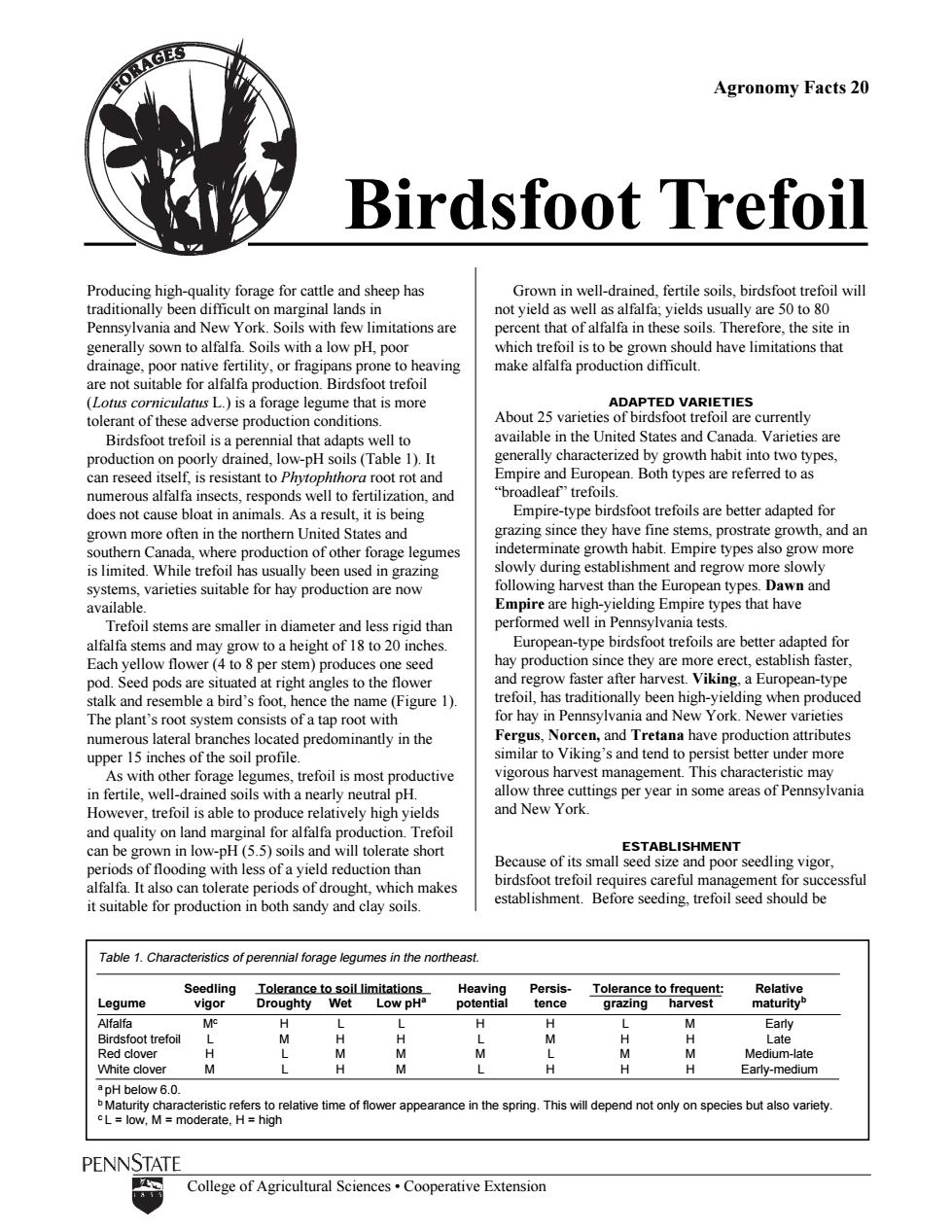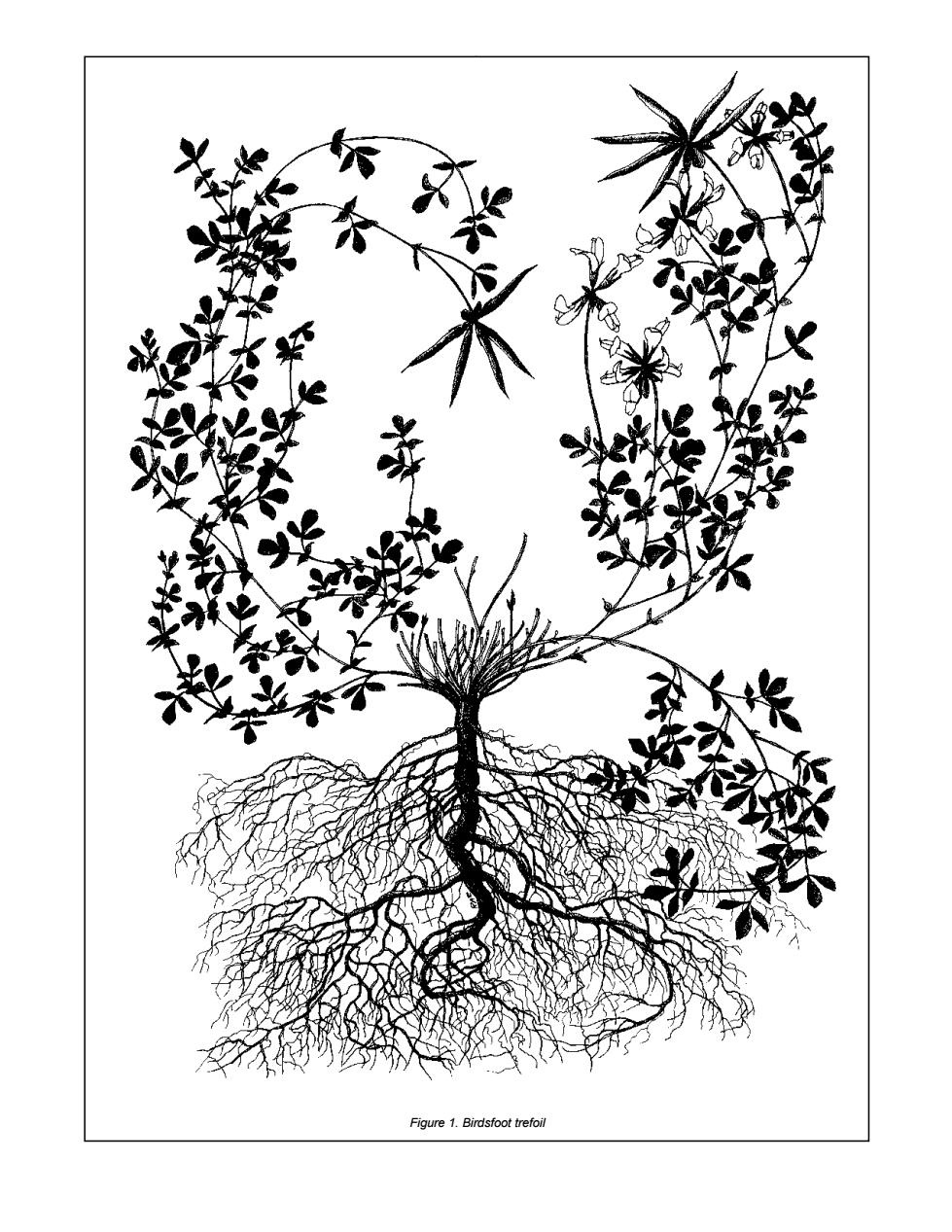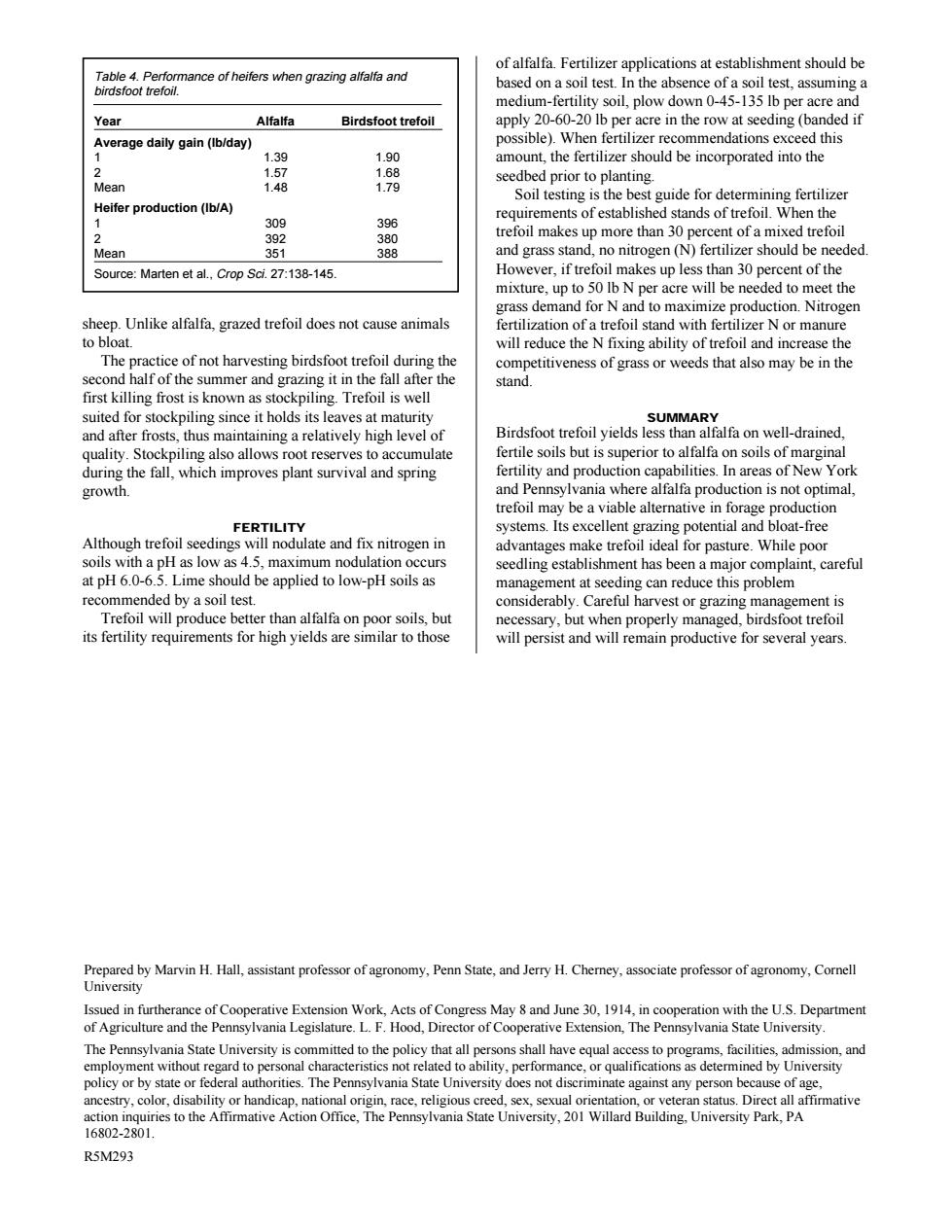
RAGES Agronomy Facts 20 Birdsfoot Trefoil Pennsylvania and New York.Soils with few limitations are generally sown to alfalfa.Soils with a low pH,poor which trefoil is to be grown should have limitations that arainage,poor native eduction Birdsfoot trefoil make alfalfa production difficult. tolerant of these adverse production conditions. Birdsfoot trefoil is a perennial that adapts well to Statesand Varieties are poorly draind,ow-(Table 1).It rpDotyrreredo and does not cause bloat in animals.Asa result,it is being Empire-type bi grown more ofen in the northern United States and urnsblishmntr Cmpire are high-y ngEmpire types that have and less rigid than 0& 8to20 ncne European-type birdsfoot better adapted for hay production since they are more erect,establish faster. pod.Seed pods are situated at to the ower wfaster after harves iki ga European-type stalk and resemble a bird's foot ence the name(Figure 1). The plant's ro in the Fergus,Norcen,and Tretana have production attributes similar to Viking's and tend to persist better under more As with other forage legumes,trefoil is most productive I pH and New York own in low-pH (55)soils and will tolerate short birdsfoot trefoil requires careful management fors essful establishment.Before seeding.trefoil seed should be sandy and Table 1.Characteristics of p nial forage legumes in the northeast cgume White clover pH below6.0. tive time of f ower appearance in the spring.Thisv epend not only on species but also variety PENNSTATE College of Agricultural SciencesCooperative Extension
College of Agricultural Sciences • Cooperative Extension Birdsfoot Trefoil Grown in well-drained, fertile soils, birdsfoot trefoil will not yield as well as alfalfa; yields usually are 50 to 80 percent that of alfalfa in these soils. Therefore, the site in which trefoil is to be grown should have limitations that make alfalfa production difficult. ADAPTED VARIETIES About 25 varieties of birdsfoot trefoil are currently available in the United States and Canada. Varieties are generally characterized by growth habit into two types, Empire and European. Both types are referred to as “broadleaf” trefoils. Empire-type birdsfoot trefoils are better adapted for grazing since they have fine stems, prostrate growth, and an indeterminate growth habit. Empire types also grow more slowly during establishment and regrow more slowly following harvest than the European types. Dawn and Empire are high-yielding Empire types that have performed well in Pennsylvania tests. European-type birdsfoot trefoils are better adapted for hay production since they are more erect, establish faster, and regrow faster after harvest. Viking, a European-type trefoil, has traditionally been high-yielding when produced for hay in Pennsylvania and New York. Newer varieties Fergus, Norcen, and Tretana have production attributes similar to Viking’s and tend to persist better under more vigorous harvest management. This characteristic may allow three cuttings per year in some areas of Pennsylvania and New York. ESTABLISHMENT Because of its small seed size and poor seedling vigor, birdsfoot trefoil requires careful management for successful establishment. Before seeding, trefoil seed should be Table 1. Characteristics of perennial forage legumes in the northeast. Seedling Tolerance to soil limitations Heaving Persis- Tolerance to frequent: Relative Legume vigor Droughty Wet Low pHa potential tence grazing harvest maturityb Alfalfa Mc H L L H H L M Early Birdsfoot trefoil L M H H L M H H Late Red clover H L M M M L M M Medium-late White clover M L H M L H H H Early-medium a pH below 6.0. b Maturity characteristic refers to relative time of flower appearance in the spring. This will depend not only on species but also variety. c L = low, M = moderate, H = high Agronomy Facts 20 Producing high-quality forage for cattle and sheep has traditionally been difficult on marginal lands in Pennsylvania and New York. Soils with few limitations are generally sown to alfalfa. Soils with a low pH, poor drainage, poor native fertility, or fragipans prone to heaving are not suitable for alfalfa production. Birdsfoot trefoil (Lotus corniculatus L.) is a forage legume that is more tolerant of these adverse production conditions. Birdsfoot trefoil is a perennial that adapts well to production on poorly drained, low-pH soils (Table 1). It can reseed itself, is resistant to Phytophthora root rot and numerous alfalfa insects, responds well to fertilization, and does not cause bloat in animals. As a result, it is being grown more often in the northern United States and southern Canada, where production of other forage legumes is limited. While trefoil has usually been used in grazing systems, varieties suitable for hay production are now available. Trefoil stems are smaller in diameter and less rigid than alfalfa stems and may grow to a height of 18 to 20 inches. Each yellow flower (4 to 8 per stem) produces one seed pod. Seed pods are situated at right angles to the flower stalk and resemble a bird’s foot, hence the name (Figure 1). The plant’s root system consists of a tap root with numerous lateral branches located predominantly in the upper 15 inches of the soil profile. As with other forage legumes, trefoil is most productive in fertile, well-drained soils with a nearly neutral pH. However, trefoil is able to produce relatively high yields and quality on land marginal for alfalfa production. Trefoil can be grown in low-pH (5.5) soils and will tolerate short periods of flooding with less of a yield reduction than alfalfa. It also can tolerate periods of drought, which makes it suitable for production in both sandy and clay soils

Figure 1. Birdsfoot trefoil

inoculated with Rhizobium lupini bacteria,which are comnetition for light becomes too great and before the root system and adequate atmospheric companion crop begins to lodge.For pure seedings of mseed necessitates that it be placed no trefoil,chemical weed control is generally necessary deeper than 1/4 inch in the soil to achieve maximum stands eeds grow faster and are more competitive Trefoil establishment in soils with a pH less than 5.6 may result in molybdenum(Mo)deficiencies.Molybdenum ation.W hen needed, of the trefoil stand NheaebaaevESTaceaeTesniae taken at 1/10th bloom and a second cutting in mid to late ield 25 Emergence trefoil plant is totally defoliated in midsummer when root eserves are low alfalfa to Fusar -type 1.5 survive as long as afafa.To maintain a stand of trefoil.it Depth of Seeding(inches) is necessary to use a management system that allows the oll to res Memoir 261 spring t a grass mixture.Trefoil will compete under continuous grazing better than alfalfa.However,clo continuous Firming the soil before and after planting will improve grazing is not recommen ontact,which improves y the seed and uti mate he summer acre are considered adequate under normal conditions Harvesting or grazing betw than are possible survival and growth the following spri Birdsfoot trefoil quality is greater than that of alfalfa obtain a 50:50 birdsfoot trefoil:grass stand are listed in bypas tein and sma ems )However.leaf loss during hay making may be greater than alfalfa.When grazed,trefoil is development seedling vigor.stand density.and vield of TteSedngatesorbastorteolwtasngegrasn Species Ib/A Birdsfoot trefo Species Bud 6-8 ith any one ese grasses TDN chardgrass 2 oth bror Source:Penn State Univ.Agric.Exp.Stn.Bull.753. imothy
inoculated with Rhizobium lupini bacteria, which are specific for birdsfoot trefoil. This will ensure sufficient nodulation of the root system and adequate atmospheric nitrogen fixation. Trefoil’s small seed necessitates that it be placed no deeper than 1/4 inch in the soil to achieve maximum stands and yields (Figure 2). A smooth, firm seedbed will greatly facilitate accurate depth placement of the seed. Early spring seedings are generally more successful than late summer seedings. Figure 2. Effect of seeding depth on birdsfoot trefoil emergence and yield. (Source: Cornell Univ. Agric. Exp. Stn. Memoir 261) 0 0.5 1 1.5 2 0 25 50 75 100 Percent Depth of Seeding (inches) Yield Emergence Firming the soil before and after planting will improve the seeding depth and seed-to-soil contact, which improves moisture uptake by the seed and ultimately enhances germination and emergence. Seeding rates of 8 to 10 lb per acre are considered adequate under normal conditions. Grass-birdsfoot trefoil mixtures are commonly used to obtain higher yields than are possible with a pure stand of trefoil. A grass-trefoil mixture can reduce trefoil lodging and curing time for hay. Recommended seeding rates to obtain a 50:50 birdsfoot trefoil:grass stand are listed in Table 2. Trefoil’s low seedling vigor has brought into question the value of a companion or nurse crop when establishing this legume. Small grain companion crops reduce root development, seedling vigor, stand density, and yield of Table 2. Seeding rates for birdsfoot trefoil with a single grass in mixture. Species lb/A Birdsfoot trefoil 6-8 with any one of these grasses Orchardgrass 2-4 Perennial ryegrass 4-8 Reed canarygrass 6-8 Smooth bromegrass 6-8 Timothy 2-4 trefoil. If a companion crop is used, it should be seeded in 18-inch row spacings and removed early before competition for light becomes too great and before the companion crop begins to lodge. For pure seedings of trefoil, chemical weed control is generally necessary because most weeds grow faster and are more competitive than trefoil. Trefoil establishment in soils with a pH less than 5.6 may result in molybdenum (Mo) deficiencies. Molybdenum is an essential nutrient for nitrogen fixation. When needed, Mo can be applied as a seed coating. This method of application should provide sufficient Mo levels for the life of the trefoil stand. HARVEST MANAGEMENT When trefoil is harvested as hay, the first cutting should be taken at 1/10th bloom and a second cutting in mid to late August. Sufficient time for regrowth between cuttings or grazing is recommended to maintain the stand. Root reserves may not be sufficient to initiate regrowth if the trefoil plant is totally defoliated in midsummer when root reserves are low. Trefoil is not as resistant as alfalfa to Fusarium-type diseases. Therefore, individual trefoil plants will not survive as long as alfalfa. To maintain a stand of trefoil, it is necessary to use a management system that allows the trefoil to reseed itself. Heavy grazing pressure may be needed in the spring to reduce lush growth and to allow trefoil to better compete in a grass mixture. Trefoil will compete under continuous grazing better than alfalfa. However, close, continuous grazing is not recommended because trefoil regrowth depends on energy supplied by top growth. Unlike alfalfa, trefoil does not maintain high levels of root reserves during the summer. Harvesting or grazing between September 1 and the first killing frost is not recommended. This period is needed to allow root reserves to accumulate to improve winter survival and growth the following spring. Birdsfoot trefoil quality is greater than that of alfalfa because of increased “bypass” protein and smaller stems. Loss of quality with maturity is less pronounced with trefoil than alfalfa (Table 3). However, leaf loss during hay making may be greater than alfalfa. When grazed, trefoil is more palatable than alfalfa and produces greater average daily gains and meat yield per acre for heifers (Table 4) and Table 3. Total digestible nutrient (TDN) content of alfalfa and birdsfoot trefoil at three maturity stages (three-year averages). Maturity Species Bud 10% bloom 50% bloom % TDN Alfalfa 62.5 54.1 52.1 Birdsfoot trefoil 65.8 62.6 58.2 Source: Penn State Univ. Agric. Exp. Stn. Bull. 753

of alfalfa Fertilizer applications at establishment should be based on a soil test.In the absence of a soil test,assuming a Birdsfoot trefoil n the row rage daily gain(Ib/day) ng this amount,the fertilizer should be incorporated into the Mean seedbed prior to planting. Heifer production (lb/A) ng is the 30 ent ofa mixed trefoil and grass stand.no nitrogen (N)fertilizer should be needed. Source:Marten et al..:138-145. However.if trefoil makes up less than 30 percent of the mixture.up tN per acre will be needed meet the sheep.Unlike alfalfa,grazed trefoil does not cause animals ftre stand with ferNormure to bloat. first killin frost is known as stockpiling Trefoil is well o比 will reduce the N fixing ability of trefoil and increase the suited for stockpiling since it holds its leaves at maturity and after fro thus mai aining a relatively high level of BirdsoteolyelsSmmRYlaonel-daned ertile soils but is growth. and alfalfa production is not optimal refoil may be a ag Athoughteiolsoedng5ETolaieandf低nitrogenin dvantage make trefoil ideal for pasture.While p seedling establishment has been a major complaint,careful at pH 6.0 me prouce better than poor soils,but its fertility requirements for high yields are similar to those MarnHyPenn aeand Jy H Chemey.oronomy.Comll otAednfirthera facil ,and employment without RSM293
Table 4. Performance of heifers when grazing alfalfa and birdsfoot trefoil. Year Alfalfa Birdsfoot trefoil Average daily gain (lb/day) 1 1.39 1.90 2 1.57 1.68 Mean 1.48 1.79 Heifer production (lb/A) 1 309 396 2 392 380 Mean 351 388 Source: Marten et al., Crop Sci. 27:138-145. sheep. Unlike alfalfa, grazed trefoil does not cause animals to bloat. The practice of not harvesting birdsfoot trefoil during the second half of the summer and grazing it in the fall after the first killing frost is known as stockpiling. Trefoil is well suited for stockpiling since it holds its leaves at maturity and after frosts, thus maintaining a relatively high level of quality. Stockpiling also allows root reserves to accumulate during the fall, which improves plant survival and spring growth. FERTILITY Although trefoil seedings will nodulate and fix nitrogen in soils with a pH as low as 4.5, maximum nodulation occurs at pH 6.0-6.5. Lime should be applied to low-pH soils as recommended by a soil test. Trefoil will produce better than alfalfa on poor soils, but its fertility requirements for high yields are similar to those Prepared by Marvin H. Hall, assistant professor of agronomy, Penn State, and Jerry H. Cherney, associate professor of agronomy, Cornell University Issued in furtherance of Cooperative Extension Work, Acts of Congress May 8 and June 30, 1914, in cooperation with the U.S. Department of Agriculture and the Pennsylvania Legislature. L. F. Hood, Director of Cooperative Extension, The Pennsylvania State University. The Pennsylvania State University is committed to the policy that all persons shall have equal access to programs, facilities, admission, and employment without regard to personal characteristics not related to ability, performance, or qualifications as determined by University policy or by state or federal authorities. The Pennsylvania State University does not discriminate against any person because of age, ancestry, color, disability or handicap, national origin, race, religious creed, sex, sexual orientation, or veteran status. Direct all affirmative action inquiries to the Affirmative Action Office, The Pennsylvania State University, 201 Willard Building, University Park, PA 16802-2801. R5M293 of alfalfa. Fertilizer applications at establishment should be based on a soil test. In the absence of a soil test, assuming a medium-fertility soil, plow down 0-45-135 lb per acre and apply 20-60-20 lb per acre in the row at seeding (banded if possible). When fertilizer recommendations exceed this amount, the fertilizer should be incorporated into the seedbed prior to planting. Soil testing is the best guide for determining fertilizer requirements of established stands of trefoil. When the trefoil makes up more than 30 percent of a mixed trefoil and grass stand, no nitrogen (N) fertilizer should be needed. However, if trefoil makes up less than 30 percent of the mixture, up to 50 lb N per acre will be needed to meet the grass demand for N and to maximize production. Nitrogen fertilization of a trefoil stand with fertilizer N or manure will reduce the N fixing ability of trefoil and increase the competitiveness of grass or weeds that also may be in the stand. SUMMARY Birdsfoot trefoil yields less than alfalfa on well-drained, fertile soils but is superior to alfalfa on soils of marginal fertility and production capabilities. In areas of New York and Pennsylvania where alfalfa production is not optimal, trefoil may be a viable alternative in forage production systems. Its excellent grazing potential and bloat-free advantages make trefoil ideal for pasture. While poor seedling establishment has been a major complaint, careful management at seeding can reduce this problem considerably. Careful harvest or grazing management is necessary, but when properly managed, birdsfoot trefoil will persist and will remain productive for several years